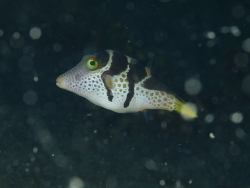Info
(Bleeker, 1853)
Canthigaster valentini lives at depths of 1 to 55 meters in coral reefs. Like most species of its genus, it remains small with a maximum length of about 11 centimeters.
It feeds on red and green algae, as well as small invertebrates. These include small echinoderms, bristle worms, and also mollusks.
Pufferfish usually need very good water conditions, otherwise they tend to get eye diseases easily. Pufferfish, from the experience of other keepers, live about 5-7 years.
fishbase: Poisonous to eat
Feeding information
They like to eat a lot when they can.... Preferably crustaceans and molluscs with shells, regular feeding with molluscs, crabs and lobsters keeps their teeth short. Otherwise, these will have to be filed down by an expert veterinarian on the anesthetized fish if fed incorrectly.
Socialization problems
The attitude with invertebrates e.g. shrimps, holds the danger to be regarded as food likewise certain crust anemones.
About the further attitude we refer gladly to the many comments of the keepers.
Can easily be confused with the mimicry filefish Paraluteres prionurus!
Synonyms:
Cathigaster valentini (Bleeker, 1853)
Tetraodon gronovii Cuvier, 1829
Tetraodon valentini Bleeker, 1853
Tetrodon taeniatus Peters, 1855
Puffer fish can produce toxins such as tetrodotoxin and saxitoxin and accumulate them in the skin, gonads and liver.
The toxin tetrodotoxin, which is contained in the fugu, is 1000 times more toxic than cyanide and there is no antidote serum, death then occurs by respiratory paralysis
The degree of toxicity varies depending on the species, but also on the geographical area and season.
We recommend that you never prepare puffer fish yourself, as the risk of fatal poisoning is far too great.
If you still absolutely want to eat puffer fish meat (fugu), then the fish should only be slaughtered by a Japanese special chef with a license and several years of training.
Only the training of these special chefs can guarantee the correct slaughter, complete removal and proper disposal of all toxic parts of the fish.
Canthigaster valentini lives at depths of 1 to 55 meters in coral reefs. Like most species of its genus, it remains small with a maximum length of about 11 centimeters.
It feeds on red and green algae, as well as small invertebrates. These include small echinoderms, bristle worms, and also mollusks.
Pufferfish usually need very good water conditions, otherwise they tend to get eye diseases easily. Pufferfish, from the experience of other keepers, live about 5-7 years.
fishbase: Poisonous to eat
Feeding information
They like to eat a lot when they can.... Preferably crustaceans and molluscs with shells, regular feeding with molluscs, crabs and lobsters keeps their teeth short. Otherwise, these will have to be filed down by an expert veterinarian on the anesthetized fish if fed incorrectly.
Socialization problems
The attitude with invertebrates e.g. shrimps, holds the danger to be regarded as food likewise certain crust anemones.
About the further attitude we refer gladly to the many comments of the keepers.
Can easily be confused with the mimicry filefish Paraluteres prionurus!
Synonyms:
Cathigaster valentini (Bleeker, 1853)
Tetraodon gronovii Cuvier, 1829
Tetraodon valentini Bleeker, 1853
Tetrodon taeniatus Peters, 1855
Puffer fish can produce toxins such as tetrodotoxin and saxitoxin and accumulate them in the skin, gonads and liver.
The toxin tetrodotoxin, which is contained in the fugu, is 1000 times more toxic than cyanide and there is no antidote serum, death then occurs by respiratory paralysis
The degree of toxicity varies depending on the species, but also on the geographical area and season.
We recommend that you never prepare puffer fish yourself, as the risk of fatal poisoning is far too great.
If you still absolutely want to eat puffer fish meat (fugu), then the fish should only be slaughtered by a Japanese special chef with a license and several years of training.
Only the training of these special chefs can guarantee the correct slaughter, complete removal and proper disposal of all toxic parts of the fish.







 Gymnothorax
Gymnothorax
















































